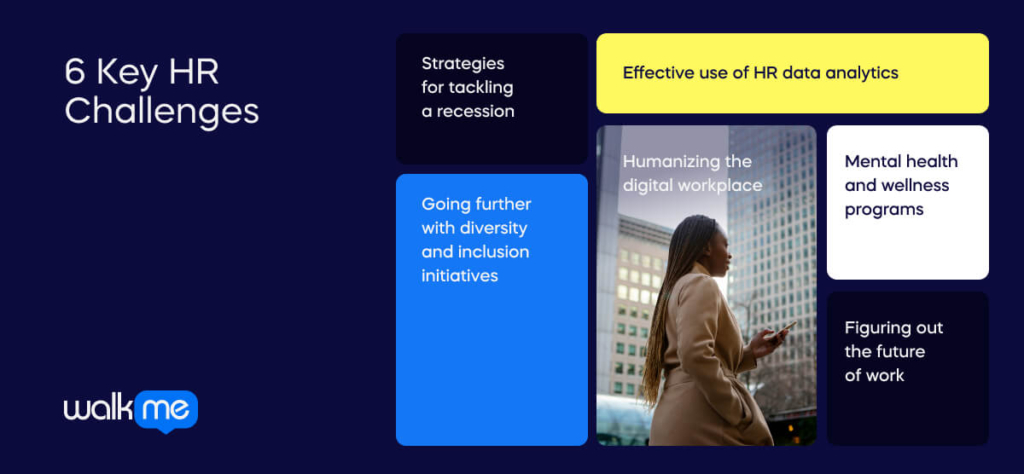Recession. Inflation. Poverty crisis.
These factors may seem distant from HR work, but they create new challenges monthly. Leading companies integrate these global issues into their HR strategies swiftly and effectively.
We’ve examined insights from thought leaders and HR professionals to identify the six most critical issues HR leaders face in 2025. These are:

- Strategies for tackling a recession
- Effective use of HR data analytics
- Humanizing the digital workplace
- Advancing diversity and inclusion initiatives
- Mental health and wellness programs
- Determining the future of work.
There are, of course, many other challenges. The final section will provide a quick overview of ongoing HR challenges.
2025 is a challenging year. While professionals introduce innovative ideas, business leaders are eager to see returns on investments. Eric Mosley even dubbed it “the year of ROI.”
By addressing these challenges, HR can deliver significant rewards.
- Strategies for tackling recession
For many HR leaders, global recession is a top challenge.
It’s impacting every industry. Uncertainty will persist, and it’s not enough to wait for this “rainy day” to pass; more challenges may lie ahead.
Recession hits HR departments hard. It could mean:
- High expectations in recruitment: Recruiting and onboarding new employees is costly. Larger organizations will still need to hire.
- Challenges for employee morale and engagement: A recession can create fear and uncertainty among employees concerned about job security and organizational stability.
- Reduced training and development opportunities: HR may need to find cost-effective ways to provide essential training and foster continuous learning.
- Budget constraints within HR: Budget cuts may limit HR’s capacity to perform essential functions and implement new initiatives, reducing staff available for innovative practices.
So, how do you tackle these problems?
- First, get the basics right: In tough times, you’ll need strong HR leaders, excellent communication, and decisive action at every level. Choices won’t be easy, but providing employees with clarity is vital.
- Be open to ideas: Consider if remote work or other flexible arrangements suit your company. Can you reduce turnover by adjusting salaries? Can you cut costs by accelerating digital transformation plans?
- Don’t be “penny-wise and pound foolish”: HR must invest in skilled professionals, compensation, and positive experiences. When reducing operational costs, make efficient long-term decisions.
In short, HR professionals should continue to excel.
Using data and HR analytics
A few years ago, Oracle reported that many organizations are finding ways to use HR analytics effectively. Their research showed that two-thirds of businesses use HR analytics well.
That was promising, but data analysis evolves. In 2025, HR teams should explore HR analytics’ potential in their business. Key growth areas include hybrid and remote work, decision-making, and innovation through digital transformation.
By the way, if you want to delve deeper, check out our guide to HR analytics.
HR analytics and hybrid work
The pandemic showed that our assumptions about office work were flawed. Some leaders want to reverse the freedoms staff have enjoyed, citing conventional wisdom like, “My grandparents never worked from home, and it never hurt them!”
In 2025, companies shouldn’t rely on vague impressions to understand remote work’s impact. HR analytics can provide data to prove what works.
HR data analytics offers a comprehensive view of employee productivity and engagement, identifies challenges in remote collaboration, and assesses communication tools’ effectiveness. It also tracks work models’ impact on well-being, work-life balance, and job satisfaction.
HR analytics for managerial decision making
HR analytics influences managerial decision-making by providing data-driven insights and evidence-based recommendations. By analyzing HR metrics like performance, turnover, training effectiveness, and engagement, HR analytics helps managers understand workforce dynamics and challenges.
These insights help identify trends, anticipate issues, and make informed decisions to optimize performance and productivity. HR analytics also aids in strategic workforce planning, talent acquisition, and succession planning, ensuring the right people with the right skills are in the right positions.
Innovations in HR analytics and data analysis
If your company feels the recession’s effects, avoiding major changes might be tempting. However, this could be the right time for a comprehensive HR transformation.
HR digital transformation enables centralized data management, real-time data access, and advanced analytics. With improved reporting and visualization, HR professionals can make informed decisions, enhance talent management, and implement data-driven recruitment and retention strategies. HR analytics supports diversity and inclusion initiatives, compliance, and risk management, fostering continuous improvement in HR and overall organizational performance.
Keeping humanity within the digital workplace
Humanization in the digital workplace is crucial as digital environments can feel dehumanized due to reduced face-to-face interactions, isolation from constant technology use, and a focus on efficiency over empathy.
HR departments can promote personal connections, encourage virtual social events, emphasize active listening, and support work-life balance. Benefits include increased satisfaction, enhanced collaboration, improved retention, reduced burnout, and overall success.
Going further with diversity
Diversity is on the business agenda, yet it remains a challenge for HR managers in 2025.
Diversity, equity, and inclusion programs are common, but their goals aren’t always ambitious. Some companies may promote diversity to enhance their brand but do little to support underrepresented groups.
HR can promote diversity through inclusive recruitment, diversity training, and supporting diverse leadership. Benefits include increased innovation, better decision-making, improved morale, enhanced creativity, a broader talent pool, and a stronger employer brand. Embracing diversity fosters a more inclusive and dynamic workplace, leading to higher productivity and a competitive edge.
Diversity and equity aren’t new in 2025, but HR departments are tasked with building better company cultures. In many industries, businesses can lead where others follow. HR departments that accept this challenge will excel in 2025.
Employee mental health and wellbeing
Following the great resignation, companies know they must work harder at employee retention. Well-being is a vital part of retention strategies.
HR can improve mental health by offering assistance programs, promoting work-life balance, and destigmatizing mental health discussions. Positive outcomes include increased productivity, reduced absenteeism, higher job satisfaction, improved teamwork, and a healthier culture that attracts and retains talent. Prioritizing mental health enhances performance and fosters a supportive environment where employees thrive.
This isn’t just a “nice to have.” Well-being leads to genuine business benefits in the short, medium, and long term. Sometimes the impact is hard to measure. However, Forrester has created a useful calculator to find the ROI from mental health programs, so there’s no excuse for confusion.
Figuring out the future of work
The “future of work” can seem daunting. After years of major challenges, the future remains uncertain.
The future of work will impact the entire company. HR management should ensure they lead decision-making.
HR professionals must adapt to new demands with evolving technologies, remote work trends, and changing demographics. They need to redefine policies, implement flexible arrangements, and support remote employees. Upskilling and reskilling to match future job requirements is essential. Navigating these complexities requires HR to be agile, proactive, and future-focused in shaping a resilient workforce for a dynamic future.
Accenture’s future of work research shows companies experimenting with work models, with mixed results. Only 35% of employees are happy with their companies’ decisions. In 2025 and beyond, there are opportunities to improve this.
Other HR challenges for 2025 (and every other year)

The challenges facing HR management in 2025 don’t end with the six we’ve listed. HR teams must also focus on the basics.
Leadership development remains essential. Making tough decisions in a fast-changing world demands more from leaders than ever. They need to be skilled in change management to facilitate new strategies and guide their companies.
With reduced budgets, providing training for managerial positions is harder. HR’s role in training and development has always been important. In 2025, training must be focused, appropriate, and useful, as the margin for error is small.
And one more word about data. HR analytics can be used to retain talent. Retaining employees is crucial in 2025, so this aspect of analysis should be utilized wherever possible.

These challenges may be perennial, but HR managers find them especially important now. When Gartner surveyed HR leaders in 2025, they found that 60% saw leader and manager effectiveness as especially important. Keeping these priorities in view will bring benefits year on year.
Recession-proof your HR department
We could summarize this article in one word: Recession.
It’ll make recruitment, retention, training, leadership, and every aspect of employee development more challenging. History shows that HR teams can offer a good ROI from their HR activities. Maintaining this in turbulent times will be more challenging than ever.

